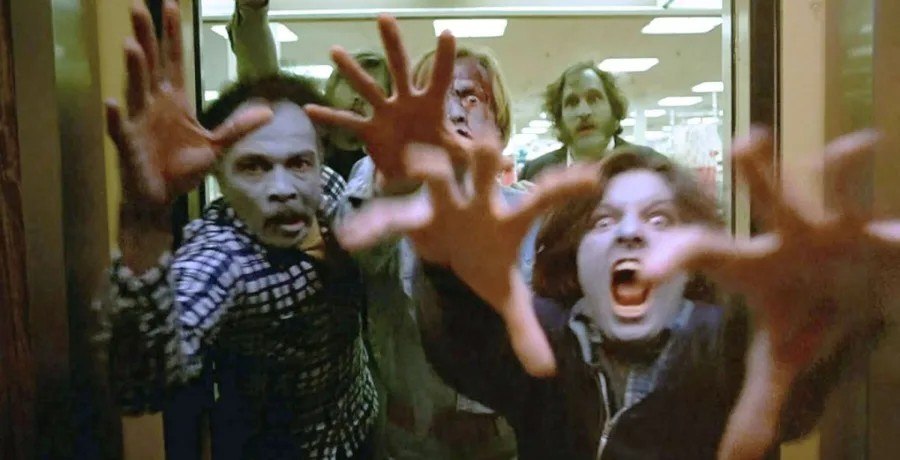Dawn of the Dead (1978)

Dawn of the Dead, directed by George A. Romero and released in 1978, stands as a seminal work in the horror genre, particularly within the realm of zombie films. Serving as a sequel to Romero’s earlier film, Night of the Living Dead, this iconic film not only popularized the zombie apocalypse subgenre but also introduced a social commentary that remains relevant today. With its blend of horror, satire, and groundbreaking special effects, Dawn of the Dead has left an indelible mark on cinema and continues to influence filmmakers and audiences alike.
The film opens in a chaotic world on the brink of collapse, where a mysterious plague has turned the majority of the population into flesh-eating zombies. The narrative follows a diverse group of survivors who find refuge in a sprawling shopping mall. Among them are a television producer named Fran (played by Gaylen Ross), her boyfriend Stephen (David Emge), a tough-as-nails police officer named Peter (Ken Foree), and a sensitive, naive character named Roger (Scott H. Reiniger). Their initial sense of safety in the mall soon gives way to a deeper exploration of human nature and society’s fragility in the face of disaster.
Romero’s direction is masterful, creating a sense of dread and tension that permeates the film. The juxtaposition of the consumerist environment of the mall with the horror of the undead creates a striking commentary on modern society. The mall, a symbol of abundance and leisure, becomes a prison for the survivors as they grapple with their dire circumstances. This setting not only serves as a backdrop for the action but also functions as a critique of consumer culture, highlighting how materialism can lead to moral decay.
The film’s special effects, overseen by Tom Savini, were groundbreaking for their time. The makeup and practical effects used to create the zombies are both horrifying and realistic, contributing to the film’s lasting impact. Scenes of gore and violence are depicted with a rawness that was shocking in the late 1970s, pushing the boundaries of what audiences were accustomed to in horror films. The iconic imagery of zombies shambling through the mall remains etched in cinematic history.
One of the film’s most powerful themes is the exploration of humanity in crisis. As the survivors navigate their new reality, they are forced to confront their own fears, desires, and moral dilemmas. The dynamics between the characters reveal the complexities of human relationships under stress. Conflicts arise not only from external threats but also from within the group, as differing ideologies and survival instincts clash. The film poignantly illustrates how fear can lead to both unity and division.

Fran, portrayed by Gaylen Ross, emerges as a strong female character in a genre often dominated by male figures. Her character embodies resilience and resourcefulness, serving as a counterpoint to the more aggressive tendencies of the male characters. Fran’s journey represents a shift in the portrayal of women in horror, as she actively participates in the group’s survival efforts rather than merely being a victim. This aspect of her character adds depth to the narrative and challenges traditional gender roles.

The film’s ending is particularly notable for its bleakness and ambiguity. As the survivors’ hopes for a safe future diminish, the film leaves viewers with a haunting sense of despair. The final scenes suggest that no place is truly safe in a world overrun by zombies, reinforcing the idea that survival comes with profound sacrifices. This tragic conclusion serves as a stark reminder of the consequences of societal collapse and the fragility of human existence.

Musically, Dawn of the Dead features a score by Goblin, an Italian progressive rock band, which enhances the film’s eerie atmosphere. The pulsating rhythms and haunting melodies complement the tension on screen, creating an immersive auditory experience. The soundtrack plays a significant role in building suspense and amplifying the emotional weight of the characters’ struggles.

In conclusion, Dawn of the Dead is not only a groundbreaking horror film but also a profound commentary on society and the human condition. George A. Romero’s masterful direction, coupled with innovative special effects and a compelling narrative, solidifies its status as a classic in the horror genre. The film’s exploration of consumerism, human relationships, and moral dilemmas in the face of an apocalypse resonates as strongly today as it did over four decades ago. Its legacy continues to inspire filmmakers and horror enthusiasts, ensuring that Dawn of the Dead remains a significant touchstone in cinematic history. Ultimately, the film invites audiences to reflect on their own humanity, challenging them to consider how they would respond in a world where the boundaries between life and death, civilization and chaos, are irrevocably blurred.











